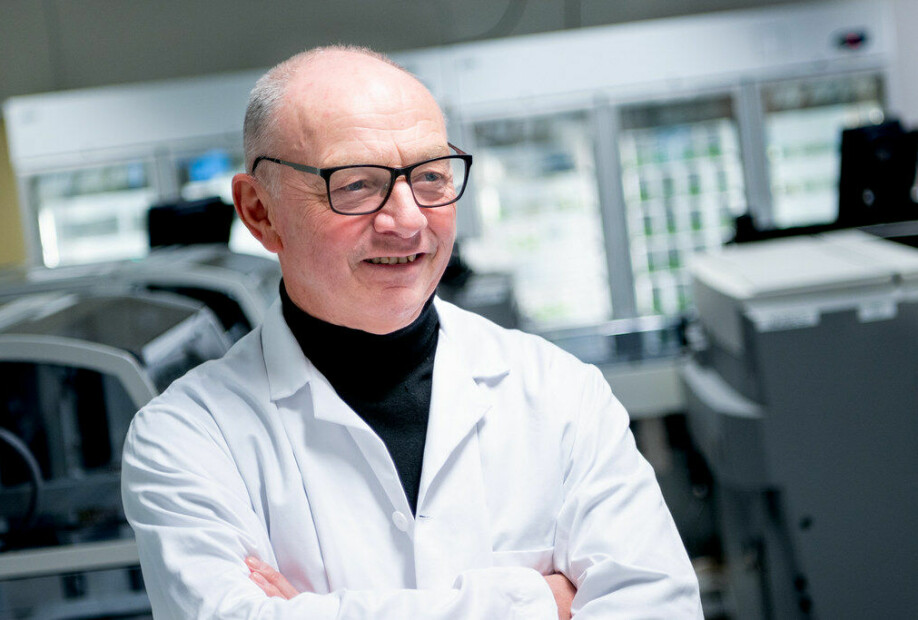
Why do so many people have chronic fatigue
In numerous diseases, such as celiac disease and psoriasis, chronic fatigue is actually the biggest problem. But what actually causes it? Professor Roald Omdal believes the fatigue response is an ancient biological protection mechanism.
When we hear that someone has multiple sclerosis (MS), what first comes to mind might be that they are paralyzed or wheelchair bound. We associate celiac disease with abdominal pain, psoriasis with skin eruptions and Sjögren's syndrome with dry eyes and mouth.
But for many who suffer from these disorders, fatigue is the biggest problem. This is also the case with other diseases, such as cancer, stroke and nerve-damaging diseases like Alzheimer's and Parkinson's.
Patients with chronic fatigue experience crippling exhaustion that is not resolved by sleep and rest.
A Norwegian study from 2021 showed that eight out of ten MS patients experience fatigue.
“Some patients describe the condition as the battery being completely empty. For others, chronic fatigue causes brain fog, and they’re unable to concentrate, may have difficulty staying attentive and feel like they’re thinking more slowly,” says Line Broch, a physician and one of the researchers behind the study.
For most people, the exhaustion is chronic, but the condition varies greatly from person to person.
“Some people have chronic fatigue permanently, while for others it comes and goes. Some experience it all day long, for others it hits later in the afternoon,” says Broch, who is a senior consultant neurologist at Drammen Hospital and a researcher at Oslo University Hospital.
Celiac disease and intestinal problems
Another doctor who is very familiar with the phenomenon is Professor Knut Lundin at the University of Oslo. He has been treating and researching patients with celiac disease for several years.
“We believe fatigue is a significant problem for patients with celiac disease,” he says.
Lundin explains that celiac disease can be difficult to detect because the symptoms are so varied. Not everyone experiences abdominal pain and digestive problems, but three signs should always make a doctor suspect celiac disease:
Iron deficiency, stomach rumbling – and constant tiredness.
Lundin says that fatigue is also very common in other intestinal disorders like inflammatory bowel disease (IBD) and irritable bowel syndrome (IBS).
We know surprisingly little about what causes this exhaustion, despite the fact that so many people struggle with it.
Lundin summarized the research done on celiac disease and fatigue in 2018 and found large gaps in the knowledge base. The studies were few in number and had several weaknesses.
Why do we know so little about this condition?
Little interest in fatigue
Both Lundin and Broch believe that the knowledge gap may be related to the fact that fatigue is a subjective and diffuse symptom that is difficult to define and measure, leading to decreased interest among doctors and researchers.
“In many parts of medicine, there is a tendency for doctors to relate more to measurable aspects than how the patient feels,” Lundin says.
Another issue is that no good treatment exists for fatigue.
“Doctors typically ask patients about what they think they can do something about. There’s less interest in ailments we can’t fix,” says Lundin.
This probably results in a vicious circle: We have little understanding and little treatment for exhaustion. This in turn creates less interest and desire for research that could provide helpful knowledge and medicine.
Fatigue remains a somewhat fuzzy phenomenon, and many patients experience being met with distrust and lack of compassion by their family, work colleagues and at the doctor's office.
But not all professionals have been intimidated. Roald Omdal’s response was the exact opposite.

20 years of research on fatigue
Today, Omdal works at Stavanger University Hospital and the University of Bergen. But his story begins much earlier.
As a PhD candidate in Tromsø in the 1990s, Omdal studied how the autoimmune disease lupus affected the brain.
The young doctor believed patients struggled most with memory and thinking problems. Soon, however, he found that exhaustion was a much bigger challenge.
Knowledge about the phenomenon was scant. Fatigue was often considered a mental problem.
Omdal nevertheless thought it strange that such pervasive exhaustion would not have biological explanations. This was the start of a 20-year long search for the biomedical mechanisms behind chronic fatigue.
He and his colleagues have found traces both in genes and in chemical processes that are linked to fatigue.
Omdal believes that a picture is beginning to emerge that chronic fatigue is linked to an ancient protection mechanism.
Injured animals become lethargic
“When animals and humans are injured or become infected, we become lethargic, tired and depressed. We become withdrawn and lose our appetite and desire for social contact,” Omdal says.
“This is part of a complex behaviour that has been very strongly preserved throughout evolution.”
In other words, the behaviour is genetically determined and found in many different animals that are far apart on the taxonomic tree of life. This means the trait must have arisen early in their development and was then preserved in all these creatures.
Something preserved in this way is a clear sign that the trait is useful. Those who have it are better equipped to survive and have offspring than those who do not.
Historically, illness behaviour probably led us to hide from predators and other dangers when we were weak and vulnerable. Herd animals also limit infections that can affect their offspring or the group they depend on to survive.
Useful mechanism that gets bungled
Research on animals has shown that fatigue is an important part of illness behaviour. The feeling of exhaustion is created by the brain, but is affected by things that happen in the body.
Different genes – typically genes involved in our ancient system of innate immunity – play an important role both in their ability to trigger fatigue and how strong it becomes. It is actually possible to remove fatigue completely in mice by removing some of these genes, says Omdal.
“Then the mice don’t succumb to fatigue no matter how sick they get,” he says.
Omdal believes that precisely this deeply preserved biological feature contributes to causing fatigue in people with chronic diseases.
“At its core, fatigue is a beneficial mechanism that protects us when we’re injured or get an infection,” he says.
However, fatigue and illness behaviour are designed for short-term illness. When a disease persists and becomes chronic, the mechanism is no longer useful. A persistent disease state triggers chronic fatigue that can last for months or years.
Genes and epigenetics
Omdal believes that a lot of clues now point to chronic fatigue being due to this ancient protection mechanism in a number of diseases.
He and his colleagues have discovered several genes that are linked to fatigue in diseases like Sjögren's syndrome and psoriasis.
They also found that epigenetic changes can come into play. Epigenetic changes refer to factors in the environment that can turn genes on and off. The study showed that patients with high and low fatigue levels have different epigenetic regulation.
They have also discovered clues showing that fatigue in people with autoimmune disease is actually linked to genes that initially are useful.
Many patients had genes for severe fatigue
Omdal’s and his colleagues’ thinking went as follows:
If a trait is useful, individuals with this trait will more often survive and have children. In this way, genes that confer this trait become increasingly common in the population.
The researchers looked at a gene that has been linked to fatigue in patients with Sjögren's syndrome. Different variants of this gene cause different degrees of fatigue.
“If fatigue is a useful trait in principle, you would expect that gene variants that contribute to a lot of fatigue would be more common than variants that only contribute slightly,” says Omdal.
“And that was exactly what we found.”

This supports the hypothesis that fatigue and illness behaviour are actually a useful trait, which unfortunately is not as beneficial when the disease lasts a long time.
Signal substance causes fatigue
Omdal and his colleagues have also conducted studies to determine which signalling mechanisms in the body cause fatigue.
By examining patients’ spinal fluid, they were able to get an impression of which neurotransmitters are present in the brain. “Our findings show that the fluid contains neurotransmitters that we know cause fatigue,” says Omdal.
For example, the neurotransmitter interleukin-1 beta appears to play an important role. The immune system creates this neurotransmitter in cases of injury and infection. When the drug enters the brain, it causes fatigue and illness behaviour.
At this level, the picture becomes extremely complex.
The body has innumerable neurotransmitters of this type, which can have many different effects. The same substance can yield different effects and different substances can cause the same effect.
Not all studies show that interleukin-1 beta plays a significant role.
Extremely complicated
Lundin warns against believing that we can find a simple connection that explains the mechanisms behind fatigue – like a key in a lock.
“The recent science has shown that extremely complex networks make up the picture,” he says.
When researchers create very simple models, where a single cell in a test tube is exposed to a signal substance, they can see that a substance leads to a certain change.
“But even here, hundreds of genes are involved.”
So you can only imagine how entangled it all becomes in the body, where we’re dealing with hundreds of thousands of cells and a bunch of different neurotransmitters.
To make matters even more complicated, a disease does not affect all patients in the same way. Lundin highlights the recent genetic research on inflammatory bowel disease. The results show that 200 different genes can contribute to the disease. Each of these genes can present in several varieties.
“What this means in practice is that no two patients are identical,” Lundin says.
Multiple mechanisms potentially involved
Omdal also does not believe in any simple solution. He envisions that many different mechanisms in the body can lead to the same result – fatigue.
This makes sense if fatigue is due to activation of illness behaviour. Since illness behaviour is so important for survival, the body has developed numerous ways to trigger it, he believes.
This in turn means that chronic fatigue in someone with cancer is not necessarily caused in the same way as in someone with celiac disease or MS.
Broch says that various causes can also be behind fatigue in patients with the same disease.
“In MS, we describe fatigue as either primary or secondary,” she says.
Primary fatigue is linked to the disease process in the brain – that is, the immune system's attack on nerve cells.
But MS also causes problems such as difficulty sleeping or pain, which in turn can trigger fatigue – so-called secondary fatigue. Secondary fatigue can also be related to anxiety, depression and the side effects of medication, Broch says.
Omdal confirms that pain and fatigue are strongly linked, meaning that treatment to alleviate the pain can also reduce fatigue.
But in general, treating fatigue is difficult. To date, no medication or treatment exists that is broadly effective.
Treating the disease doesn’t always help
Treating ailments when we don’t know much about the mechanisms that cause them is often difficult.
Cardio training has often been shown to have a positive effect on fatigue in chronic diseases, even if the effect is not that substantial.
Patients may also experience fewer ailments with fatigue when they receive treatment for the underlying disease, typically drugs that alter the activity of the immune system.
But it doesn’t always help.
“What we’ve observed is that the disease activity is not necessarily related to the degree of fatigue, either before or after treatment,” says Omdal.
A recently published Norwegian study on the inflammatory bowel disease ulcerative colitis shows this to be the case.

Inflammation disappeared, but not the exhaustion
The researchers first examined a group of patients with active disease symptoms. Then they ran new tests after three months of treatment for ulcerative colitis. By then, some of the patients’ guts had recovered.
However, the patients had not become any less exhausted. Nor was there any difference in fatigue between patients whose intestines had benefited from treatment and those who still had active inflammation.
Why didn’t the fatigue diminish when the inflammation subsided?
Are the patients’ immune systems still active? Or are other mechanisms contributing to the fatigue? For example, researchers find good reason to believe that leakage of bacteria-produced substances from the intestine could play a role.
Omdal points out that it is also well known that a number of other conditions or factors, like depression or psychosocial conditions, can affect the experience of fatigue.
He says that there is a clear connection between exhaustion and depression. This fits well with the hypothesis that fatigue is due to the brain activating illness behaviour, which is also linked to depression.
Much remains to be done
Omdal and his colleagues have come a long way towards a new understanding of what lies behind the crippling exhaustion that afflicts so many patients. Nevertheless, a lot of research remains.
It will be especially important to investigate what happens in the bodies of people with long-term fatigue after having Covid-19, Omdal notes.
The researchers face numerous challenges.
At present, says Omdal, we don’t have any objective methods for measuring fatigue. Doctors and researchers instead use a number of different questionnaires, and opinions vary on how they should be used and interpreted.
Not all professionals are even aware of how big a problem fatigue is. This can have major consequences for patients.
Testified in court
Lundin from the University of Oslo recently spoke about exhaustion in a lawsuit about patient injury compensation. An error had led to the patient not being diagnosed with celiac disease. Severe exhaustion led to her becoming disabled, before the error was finally corrected and the diagnosis made.
“She was refused patient compensation because fatigue was said to have nothing to do with celiac disease. I wrote a rather harsh statement stating the opposite,” says Lundin.
Omdal confirms the problem.
“Acceptance has been slow in coming for the fact that fatigue makes up part of the biology of many diseases, like celiac disease and inflammatory bowel disease.”
“We don’t have a blood test for fatigue. And doctors often have a little trouble trusting what patients say.”
Now Omdal hopes that the new knowledge about chronic fatigue will eventually change that scepticism.
———
Read the Norwegian version of this article at forskning.no
































